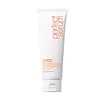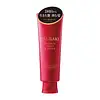What's inside
What's inside
 Key Ingredients
Key Ingredients

 Benefits
Benefits

 Concerns
Concerns

 Ingredients Side-by-side
Ingredients Side-by-side

Water
Skin ConditioningCetearyl Alcohol
EmollientSorbitol
HumectantDimethicone
EmollientDipropylene Glycol
HumectantBehentrimonium Chloride
PreservativeHydrogenated Polyisobutene
EmollientAmodimethicone
Parfum
MaskingIsopropyl Alcohol
SolventCaprylyl Glycol
EmollientLactic Acid
BufferingTrideceth-10
CleansingDisodium EDTA
1,2-Hexanediol
Skin ConditioningEthylhexylglycerin
Skin ConditioningLimonene
PerfumingArgania Spinosa Kernel Oil
EmollientSimmondsia Chinensis Seed Oil
EmollientCocos Nucifera Oil
MaskingCI 15985
Cosmetic ColorantCI 19140
Cosmetic ColorantPrunus Armeniaca Kernel Oil
MaskingOlea Europaea Fruit Oil
MaskingSclerocarya Birrea Seed Oil
HumectantCamellia Japonica Seed Oil
EmollientCoco-Caprylate/Caprate
EmollientTocopherol
AntioxidantGlycolipids
Skin ConditioningWater, Cetearyl Alcohol, Sorbitol, Dimethicone, Dipropylene Glycol, Behentrimonium Chloride, Hydrogenated Polyisobutene, Amodimethicone, Parfum, Isopropyl Alcohol, Caprylyl Glycol, Lactic Acid, Trideceth-10, Disodium EDTA, 1,2-Hexanediol, Ethylhexylglycerin, Limonene, Argania Spinosa Kernel Oil, Simmondsia Chinensis Seed Oil, Cocos Nucifera Oil, CI 15985, CI 19140, Prunus Armeniaca Kernel Oil, Olea Europaea Fruit Oil, Sclerocarya Birrea Seed Oil, Camellia Japonica Seed Oil, Coco-Caprylate/Caprate, Tocopherol, Glycolipids
Water
Skin ConditioningGlycerin
HumectantDimethicone
EmollientIsopentyldiol
HumectantHydrogenated Raspberry Seed Oil
EmollientBehentrimonium Chloride
PreservativeStearyl Alcohol
EmollientSorbitol
HumectantAminopropyl Dimethicone
Hydroxyethyl Urea
HumectantHydroxyethyl Hydroxypropyl C12-15 Alkoxypropylamine Oxide
CleansingSteartrimonium Chloride
PreservativeLactic Acid
BufferingSqualane
EmollientCamellia Seed Oil
Sodium Lauroyl Glutamate
Phytosteryl/Octyldodecyl Lauroyl Glutamate
Skin ConditioningPhytosteryl Macadamiate
Skin ConditioningGlycine Max Seed Extract
Skin ConditioningSodium Acetylated Hyaluronate
HumectantHydrolyzed Conchiolin Protein
Skin ConditioningIsopropyl Alcohol
SolventCetyl Alcohol
EmollientOctyldodecanol
EmollientAlcohol Denat.
AntimicrobialCitric Acid
BufferingAmmonium Lactate
BufferingLaurtrimonium Chloride
EmulsifyingButylene Glycol
HumectantDipropylene Glycol
HumectantAdenosine Phosphate
Skin ConditioningAmodimethicone
PPG-2-Deceth-12
EmulsifyingTocopherol
AntioxidantPhenoxyethanol
PreservativeSodium Benzoate
MaskingParfum
MaskingWater, Glycerin, Dimethicone, Isopentyldiol, Hydrogenated Raspberry Seed Oil, Behentrimonium Chloride, Stearyl Alcohol, Sorbitol, Aminopropyl Dimethicone, Hydroxyethyl Urea, Hydroxyethyl Hydroxypropyl C12-15 Alkoxypropylamine Oxide, Steartrimonium Chloride, Lactic Acid, Squalane, Camellia Seed Oil, Sodium Lauroyl Glutamate, Phytosteryl/Octyldodecyl Lauroyl Glutamate, Phytosteryl Macadamiate, Glycine Max Seed Extract, Sodium Acetylated Hyaluronate, Hydrolyzed Conchiolin Protein, Isopropyl Alcohol, Cetyl Alcohol, Octyldodecanol, Alcohol Denat., Citric Acid, Ammonium Lactate, Laurtrimonium Chloride, Butylene Glycol, Dipropylene Glycol, Adenosine Phosphate, Amodimethicone, PPG-2-Deceth-12, Tocopherol, Phenoxyethanol, Sodium Benzoate, Parfum
 Reviews
Reviews

Ingredients Explained
These ingredients are found in both products.
Ingredients higher up in an ingredient list are typically present in a larger amount.
This water-soluble silicone is used for its hydrating and softening properties. It is used to add a silky feel to skincare products and has great benefits for haircare.
In haircare, this ingredient:
- Adds shine
- Protects color
- Offers thermal protection
- Boosts hair strength
- Does not build up as easily
This ingredient is a preservative and often used for it's anti-static properties. You'll most likely see this ingredient in hair conditioners.
It does not cause irritation or sensitization in leave-on products at 1-5%.
Dimethicone is a type of synthetic silicone created from natural materials such as quartz.
What it does:
Dimethicone comes in different viscosities:
Depending on the viscosity, dimethicone has different properties.
Ingredients lists don't always show which type is used, so we recommend reaching out to the brand if you have questions about the viscosity.
This ingredient is unlikely to cause irritation because it does not get absorbed into skin. However, people with silicone allergies should be careful about using this ingredient.
Note: Dimethicone may contribute to pilling. This is because it is not oil or water soluble, so pilling may occur when layered with products. When mixed with heavy oils in a formula, the outcome is also quite greasy.
Learn more about DimethiconeDipropylene Glycol is a synthetically created humectant, stabilizer, and solvent.
This ingredient helps:
Dipropylene glycol is technically an alcohol, but it belongs to the glycol family (often considered part of the ‘good’ alcohols). This means it is hydrating and gentle on skin unlike drying solvent alcohols like denatured alcohol.
As a masking agent, Dipropylene Glycol can be used to cover the smell of other ingredients. However, it does not have a scent.
Studies show Dipropylene Glycol is considered safe to use in skincare.
Learn more about Dipropylene GlycolIsopropyl Alcohol is more commonly known as rubbing alcohol. It is most commonly used as a solvent, meaning it helps other ingredients dissolve.
This ingredient is an astringent alcohol. Astringent alcohols may also irritate skin as they high amounts may strip away your skin's natural oils.
Other types of astringent alcohols include:
According to the National Rosacea Society based in the US, you should be mindful of products with these alcohols in the top half of ingredients.
Any type of sanitizing product will have high amounts of alcohol to help kill bacteria and viruses.
Learn more about Isopropyl AlcoholLactic Acid is another well-loved alpha hydroxy acid (AHA). It is gentler than glycolic acid but still highly effective.
Its main role is to exfoliate the surface of the skin by loosening the “glue” that holds dead skin cells together. Shedding those old cells leads to smoother, softer, and more even-toned skin.
Because lactic acid molecules are larger than glycolic acid, they don’t penetrate as deeply. This means they’re less likely to sting or irritate, making it a great choice for beginners or those with sensitive skin.
Like glycolic acid, it can:
Lactic acid also acts as a humectant (like hyaluronic acid). It can draw water into the skin to improve hydration and also plays a role in the skin's natural moisturizing factor (NMF) in the form of sodium lactate.
Studies show it can boost ceramide production to strengthen the skin barrier and even help balance the skin’s microbiome.
To get results, choose products with a pH between 3-4.
Lower strengths (5-12%) focus on surface exfoliation; higher strengths (12% and up) can reach deeper in the dermis (deeper, supportive layer) to improve skin texture and firmness over time.
Though it was originally derived from milk, most modern lactic acid used in skincare is vegan. It is made through non-dairy fermentation to create a bio-identical and stable form suitable for all formulations.
When lactic acid shows up near the end of an ingredient list, it usually means the brand added just a tiny amount to adjust the product’s pH.
Legend has it that Cleopatra used to bathe in sour milk to help reduce wrinkles.
Lactic acid is truly a gentle multitasker: it exfoliates, hydrates, strengthens, and brightens. It's a great ingredient for giving your skin a smooth, glowing, and healthy look without the harshness of stronger acids.
Read more about some other popular AHA's here:
Learn more about Lactic AcidParfum is a catch-all term for an ingredient or more that is used to give a scent to products.
Also called "fragrance", this ingredient can be a blend of hundreds of chemicals or plant oils. This means every product with "fragrance" or "parfum" in the ingredients list is a different mixture.
For instance, Habanolide is a proprietary trade name for a specific aroma chemical. When used as a fragrance ingredient in cosmetics, most aroma chemicals fall under the broad labeling category of “FRAGRANCE” or “PARFUM” according to EU and US regulations.
The term 'parfum' or 'fragrance' is not regulated in many countries. In many cases, it is up to the brand to define this term.
For instance, many brands choose to label themselves as "fragrance-free" because they are not using synthetic fragrances. However, their products may still contain ingredients such as essential oils that are considered a fragrance by INCI standards.
One example is Calendula flower extract. Calendula is an essential oil that still imparts a scent or 'fragrance'.
Depending on the blend, the ingredients in the mixture can cause allergies and sensitivities on the skin. Some ingredients that are known EU allergens include linalool and citronellol.
Parfum can also be used to mask or cover an unpleasant scent.
The bottom line is: not all fragrances/parfum/ingredients are created equally. If you are worried about fragrances, we recommend taking a closer look at an ingredient. And of course, we always recommend speaking with a professional.
Learn more about ParfumSorbitol is a sugar alcohol. It is a hydrating and moisturizing agent created from the reduction process of glucose.
Most sorbitol is usually made from potato starch. It is also found in fruits such as apples and pears.
As a humectant, Sorbitol helps draw water to the skin. This helps keep the skin hydrated. Sorbitol also helps create a thicker texture in products. You might find sorbitol in your toothpaste and other gels.
It is a non-irritating ingredient that is great for those with dry skin.
Sorbitol is a prebiotic. It helps promote the growth of healthy bacteria on your skin. The bacteria on your skin form a microbiome. This microbiome helps protect your skin from infection and harmful bacteria.
Learn more about SorbitolTocopherol (also known as Vitamin E) is a common antioxidant used to help protect the skin from free-radicals and strengthen the skin barrier. It's also fat soluble - this means our skin is great at absorbing it.
Vitamin E also helps keep your natural skin lipids healthy. Your lipid skin barrier naturally consists of lipids, ceramides, and fatty acids. Vitamin E offers extra protection for your skin’s lipid barrier, keeping your skin healthy and nourished.
Another benefit is a bit of UV protection. Vitamin E helps reduce the damage caused by UVB rays. (It should not replace your sunscreen). Combining it with Vitamin C can decrease sunburned cells and hyperpigmentation after UV exposure.
You might have noticed Vitamin E + C often paired together. This is because it is great at stabilizing Vitamin C. Using the two together helps increase the effectiveness of both ingredients.
There are often claims that Vitamin E can reduce/prevent scarring, but these claims haven't been confirmed by scientific research.
Learn more about TocopherolWater. It's the most common cosmetic ingredient of all. You'll usually see it at the top of ingredient lists, meaning that it makes up the largest part of the product.
So why is it so popular? Water most often acts as a solvent - this means that it helps dissolve other ingredients into the formulation.
You'll also recognize water as that liquid we all need to stay alive. If you see this, drink a glass of water. Stay hydrated!
Learn more about Water